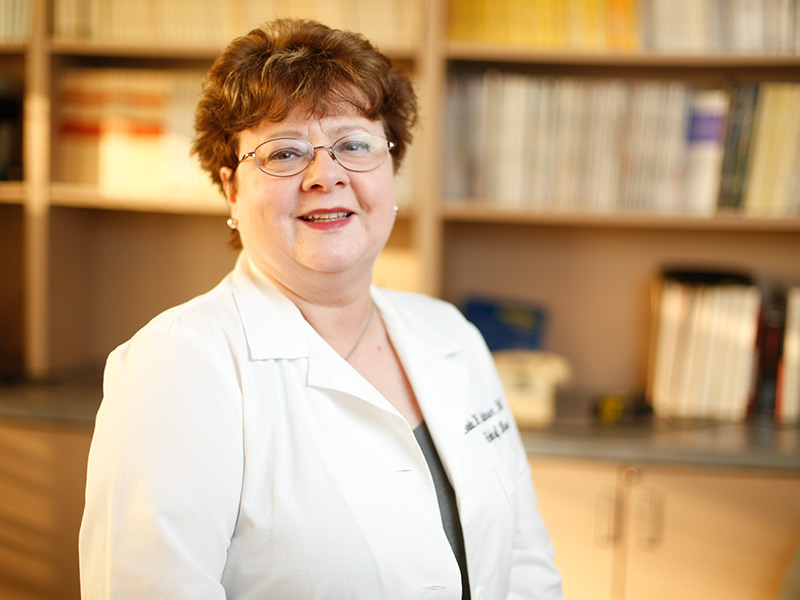Patient-oriented discovery

Illustration by James Steinberg
What drives a nurse-scientist? A problem to be solved, curiosity, observation, inquiry and passion — and a deeper, simpler motivation. Nurses want the best outcomes for their patients. Nurse-scientists and researchers are determined to find ways to make them happen.
For Terrah Foster Akard, PhD’08, MSN’01, it was wanting to help parents like a father who spoke so heartbrokenly about losing his daughter. For Cathy Maxwell, PhD’12, it was seeing injured, frail older adults admitted to the trauma department and knowing that most of them would never fully recover. Shelagh Mulvaney, PhD, wanted to help teens with diabetes help themselves. And the way lymphedema stole post-cancer patients’ abilities to enjoy life made Sheila Ridner, PhD’03, MSN’00, determined to discover how the painful condition could be diminished.
“It’s not like you just have to accept that people have to be impaired after having breast or head and neck cancer,” Ridner said. “We do not have to accept that’s just what happens.”
These four Vanderbilt University School of Nursing scientists conduct research that changes patients’ treatments and lives. They don’t do it alone. They frequently pair with nurse clinicians who implement their discoveries and help translate that research into practice and improved patient care.
Some of these partnerships are long-standing, with the clinician and researcher working together in the clinic and gathering data. Other collaborations feature nurse practitioners applying the researcher’s findings in their practice or in the classroom, providing best practices and information for the next generation of advanced practice nurses.
Nursing and health care advances need the expertise of both.
“I’m a researcher. I used to be a clinician, but I’m not the one at the bedside,” said Akard, a member of the School of Nursing’s research faculty. “If we create this amazing intervention — even if it works — if it can’t be implemented into practice, it’s a waste of time and money. It won’t matter. It will never have impact and help families. The clinicians help ensure we’re creating something that will not only matter but will also work in the practice setting — that it’s feasible and doable.”
Jennifer Kim, DNP, MSN’97, uses research about older adults conducted by Maxwell in teaching her students about frailty. “We have doctorally-prepared faculty, both PhDs and DNPs. It’s having expertise in research and in implementation, and understanding the two are really dependent on each other in advancing the concepts we’re studying,” she said.
Mariann Piano, PhD, RN, FAAN, FAHA, the Nancy and Hilliard Travis Professor of Nursing, leads Vanderbilt’s research enterprise. She directs its cadre of nurse-scientist faculty, the Center for Research Development and Scholarship, PhD program and postdoctoral program.
“As part of a major research university, we support research, scholarship and inquiry by all faculty and by our students, from PreSpecialty to our PhDs. Seeking knowledge, asking questions, looking for ways to improve patient care, collaborating and applying evidence are engrained in the school’s culture,” Piano said. “Our research mission is to transform the discipline of nursing through research, practice and partnerships, and to contribute to the health of our region, nation and the world.”
Linda D. Norman, DSN, FAAN, the Valere Potter Menefee Professor of Nursing and Dean of the School of Nursing, said that increased nursing research and collaboration with clinical nursing are key goals of the school and of the nursing profession.
“Nursing research has a pivotal role in the future of health care,” Norman said. “Nurse-led research is patient-centered research that can improve health care delivery, patient care, safety, quality and costs. Those are all factors necessary to transform health care in the U.S. and globally.” – Nancy Wise
Treating lymphedema…and easing patients’ worst fears
by Nancy Humphrey
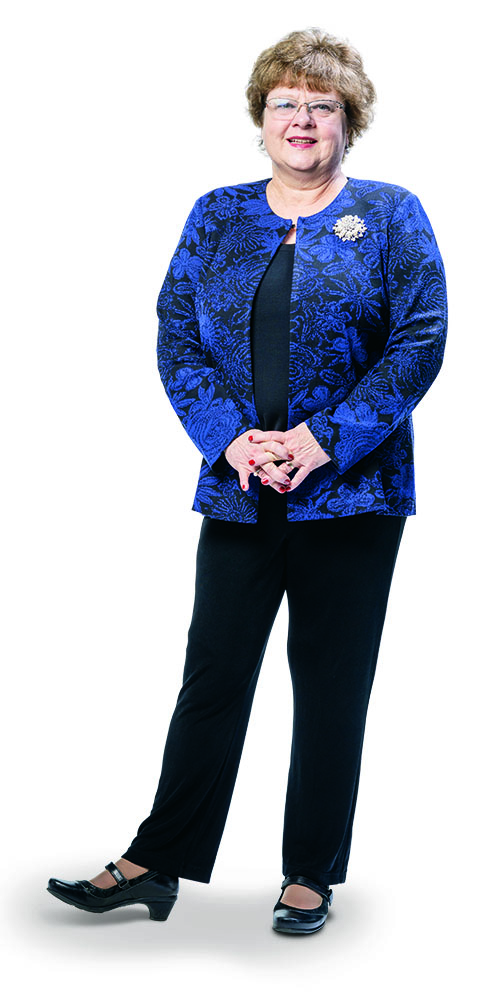
Sheila Ridner. Photo by John Russell.
Sheila Ridner had just narrowed her nursing research focus to lymphedema, a debilitating side effect of breast cancer treatment, when her mother was diagnosed with breast cancer in 2000.
“The only person who ever talked to my mother about the risk of lymphedema was me,” said Ridner, adding that her mother did develop lymphedema. “And that’s still true today. We’re not telling people about this. It’s a travesty.”
Ridner has devoted the past 19 years to researching lymphedema, the buildup of fluid in soft body tissues when the lymph system is damaged or blocked, often after cancer surgery or radiation treatments. The risk grows with the number of lymph nodes affected by the cancer. Breast cancer-related lymphedema affects between 20-30% of women. It’s diagnosed by a physical exam. About 250 million people worldwide suffer from lymphedema, including people in underdeveloped countries and hot tropical areas who can develop lymphedema due to a worm (nematode) infection.
It’s most common among women who have been treated for breast cancer, but is also found in the faces and necks of patients being treated for head and neck cancer and the legs of women being treated for ovarian cancer. Lymphedema puts patients at greater risk for infections as well as psychological stress.
“Women with lymphedema can end up with one arm or breast twice the size of the other one,” said Ridner, the Martha Rivers Ingram Professor of Nursing. Early identification and treatment of lymphedema is critical to improving the outcomes of the patients who have it. When treated in the earliest stages, complications may be minimized.
Ridner, who was honored by Sigma Theta Tau International with induction into its International Nurse Researcher Hall of Fame in 2017, worked in oncology in the late 1970s and saw patients with lymphedema where the only treatment was elevating their arms from an IV pole in an attempt to reduce fluid buildup and swelling. “It did nothing,” she said.
After obtaining her master’s degree in 2000 from VUSN, Ridner went directly into the PhD program with a focus in lymphedema. “I realized there were a lot of improvements in complications I saw in oncology patients in the 1990s, including pain, nausea, vomiting and maintaining blood counts after chemotherapy, but we had made very little progress in managing lymphedema, and there was very little research.”
Ridner’s current lymphedema research, a study launched in 2014, is looking at bioimpedance spectroscopy (BIS), a noninvasive procedure that measures lymphatic fluid and is thought to be more reliable than a tape measure for assessing a woman’s risk for developing lymphedema.
BIS is a painless procedure in which an electronic signal is run through the body. The non-invasive technology, which has been around for about 50 years, is similar to electronic monitors for body mass index.
Ridner is the principal investigator for the PREVENT controlled trial, a multisite international study aimed at identifying prelymphedema in breast cancer patients. The study compares two methods to prevent the progression of lymphedema (BIS and tape measure). In the study, women, at the time of breast cancer diagnosis,
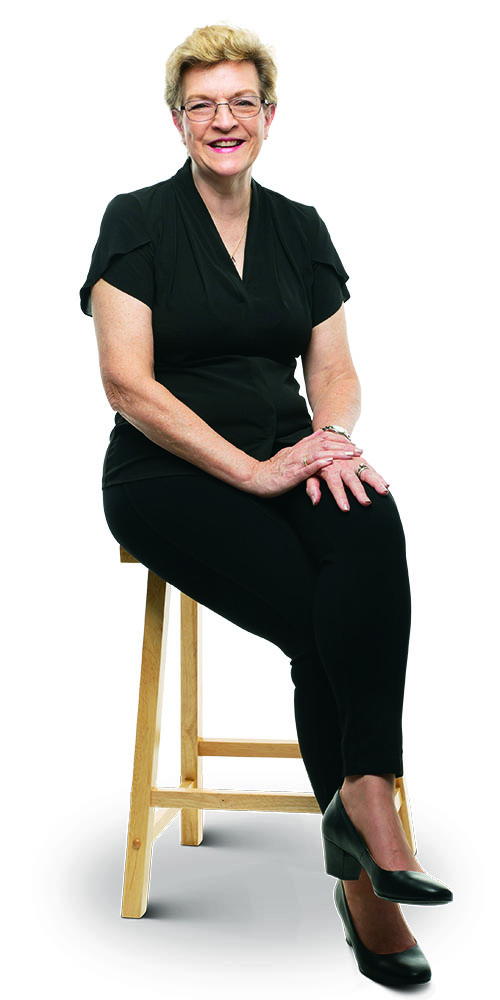
Kay Davis. Photo by Ryan Armbrust.
are prescribed compression sleeves and gauntlets to reduce lymphatic fluid in the arm.
Interim findings from the study, published on May 3 in the Annals of Surgical Oncology, show that in one-year’s data of 500 patients, BIS surveillance reduced rates of progression by about 10%, a clinically meaningful improvement.
The PREVENT trial, which will continue through December 2020, has enrolled 1,201 participants, 325 of whom are patients of the Vanderbilt Breast Center.
Ridner has just completed the study of a new device for treating lymphedema in head and neck cancer patients, which is growing in patients under 30, mainly due to the HPV virus. “That’s a demographic change in my lifetime,” Ridner said. “It used to be found in older men who smoked and drank a lot.”
The FlexitouchHead and Neck System is a lifejacket-style vest with a face enclosure to minimize face and neck swelling. Patients can use the device at home to self-manage their condition.
Kay Davis, MSN’78, BSN’77, PM’09, APRN, who received her bachelor’s and master’s degrees and a Post-Master’s Certificate from Vanderbilt, has spent the past decade as a psychiatric-mental health nurse practitioner working with a wide range of patients. Davis is also an ovarian cancer survivor and remembers her first coherent thought after her own cancer surgery – worrying she would develop lymphedema. She did not.
“Having lymphedema after breast cancer is a patient’s No. 1 fear, after dying from the cancer,” Ridner said.
Davis implements Ridner’s research into her practice and said she is pleased that she can tell her patients that during her lifetime, she has seen lymphedema move from an inevitable side effect to a treatable condition. “In my mother’s day if a woman complained about lymphedema after a mastectomy, she was told that was the price she paid for survival. Those days are past, but not by that much.”
She helps her patients deal with the depression and anxiety surrounding lymphedema. “Patients with lymphedema often need the opportunity to talk about their fears and concerns and it is vital that we provide that outlet. We all know that stress, anxiety and depression make every medical condition worse, but with lymphedema, psychiatric issues increase the likelihood of poor compliance with treatment, resulting in increased complications from the lymphedema,” Davis said.
“Due to Sheila’s research, I know what level of treatment can be accessed, and I work with my patients to obtain and maintain their treatment.”
Shifting the paradigm on aging and frailty
by Nancy Humphrey
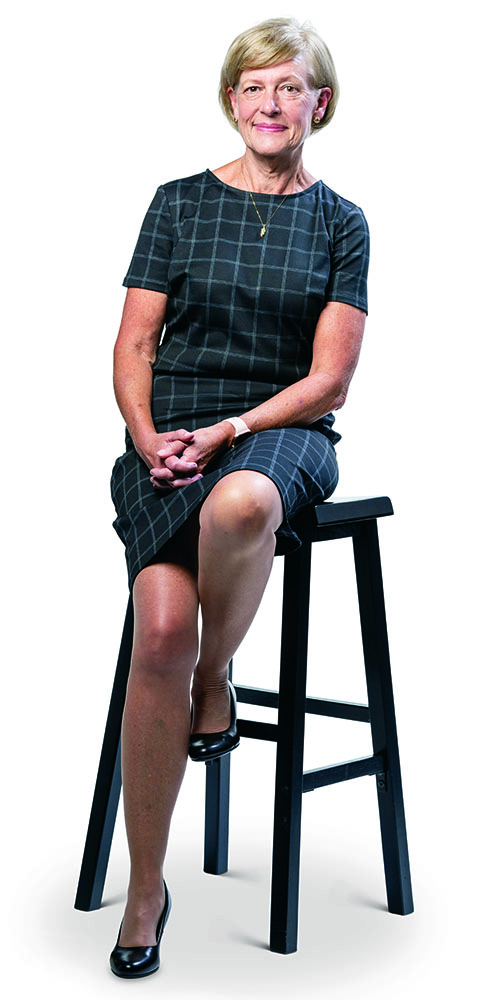
Cathy Maxwell. Photo by John Russell.
The word “frailty” commonly brings to mind the image of a stooped little old lady with a cane. But frailty is much more than that. It describes a process that older people often experience as they age. Many older people fall and must be hospitalized. The condition that is often causing the increase in falls is known as frailty – the slow loss of strength and energy over time that leads to weakness, tiredness, slowness and loss of balance.
“It’s a state of vulnerability to stressors: both internal (like infectious diseases and chronic diseases) and external (a traumatic injury). In short, frailty is the leading predictor of poor outcomes for older adults. But it’s not an appealing word,” said Cathy Maxwell, PhD’12, MSN, FAAN, who studies frailty at Vanderbilt University School of Nursing. “People don’t like to hear it. It has a stigma attached to it. But frailty is a big deal,” she said.
“Frailty reflects biological aging. Two people with a chronological age of 75 can be very different. Someone who is athletic, active and has a healthy diet is biologically a lot younger than someone who is very sedentary, who has a lot of stress, who has a bad diet,” she said.
Maxwell, assistant professor of Nursing, is working with Jennifer Kim, MSN’97, DNP, FNAP, FAANP, to see that her frailty research is applied both clinically and academically, assuring that the next generation of nurses will have frailty top of mind when seeing older patients in the community.
People typically think of aging in two ways, Maxwell said. “One side is all about vigor and vitality and AARP, smiling faces and commercials. Or there’s the other side: old and frail, close to the end of your life. Very few people face it realistically and look at the big picture,” she said. “Aging is the life process, the life course. Our physical capacity peaks at about age 30, and then we slowly began to lose that until the end of our life. It’s going to happen to every human being.”
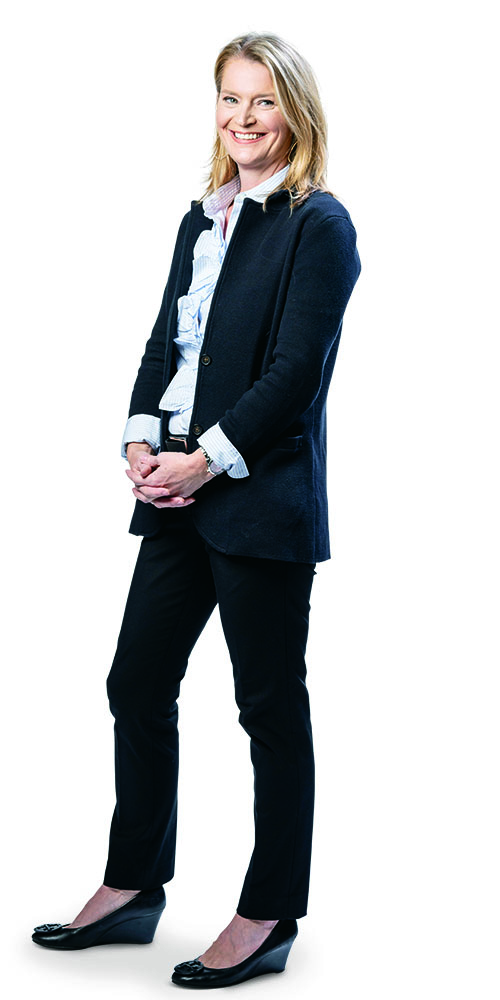
Jennifer Kim. Photo by John Russell.
Maxwell said teaching bedside nurses and nurse practitioner students at VUSN about the concept of frailty is key. Talking about it and evaluating patients for frailty can lead to longer, higher quality lives for those patients.
“Once our students finish their NP program, they’ll be going out into clinical practice and they need to be able to talk to patients and to screen for frailty.”
Maxwell, who has a clinical background in critical care and trauma, said she became interested in frailty when she noticed that outcomes of older patients were very different than younger patients. “On one level, that was intuitive, but I wanted to understand it on a deeper level,” Maxwell said.
In 2015, Maxwell taught bedside nurses at Vanderbilt University Adult Hospital how to screen for frailty. Over a three-month period, older patients admitted to the trauma unit were screened for frailty and cognitive impairment in a quick assessment. During this time, palliative care consultations for older patients increased from 13 to 34%.
“Screening is hugely important when they present in a clinical setting: an emergency department, the hospital, primary care practice or even a community setting,” Maxwell said.
Maxwell works with Kim’s adult-gerontology primary care students, lecturing about the concept of frailty, introducing her research and talking about the evidence-based screening tools available for assessment.
During her lectures, the students are asked to do a screening on someone they know. “They can actually see themselves that ‘Grandpa is frail.’ And then the students are taught about what to do with those screening results,” Kim said.
The NP students also work with standardized patients in Vanderbilt’s CELA lab, where they learn about geriatric total assessments, when it’s appropriate for a palliative care consult and how to educate patients about physical activity, etc.
Kim said it’s important for students to understand the importance of recognizing frailty as a predictor of mortality and morbidity and incorporating screening and a full assessment into their practice. And it’s necessary to reach the “younger old” with the VUSN research as well. “When they hear this information, they realize they can still do things to help themselves and that lifestyle changes can make a huge difference,” she said.
Maxwell, Kim and colleagues also produced a 36-page booklet, “Aging and Injury: Important Things to Know,” written at a seventh-grade literacy level and geared toward older adults in the community. Maxwell shares it during talks to older adults; it’s also available by request on the VUSN website.
The book talks about the bigger picture, the aging process and what to expect as people age. It also focuses on the importance of thinking about planning ahead. It presents information about the connection between frailty and falls and how the body creates energy for strength, endurance and balance.
“When people read the information, they get it,” Maxwell said. “When you connect those dots, nobody is surprised by how it happens. They see it happen to relatives and friends around them. We just connect the dots and help them understand why it’s happening.”
Next steps include continuing to train students at both Vanderbilt and other institutions on how to work with older adults They hope to take the research beyond education and discussions and into the community, conducting wellness programs with low-income seniors.
Maxwell said VUSN is uniquely qualified and positioned to merge research and implementation.
“We have doctorally-prepared faculty – both PhDs (research) and DNPs (clinical),” she said. “We have expertise in research and in implementation and we understand that the two are dependent on each other in advancing concepts, in our case, frailty.”
Giving teens with diabetes the tools and the power
by Nancy Humphrey
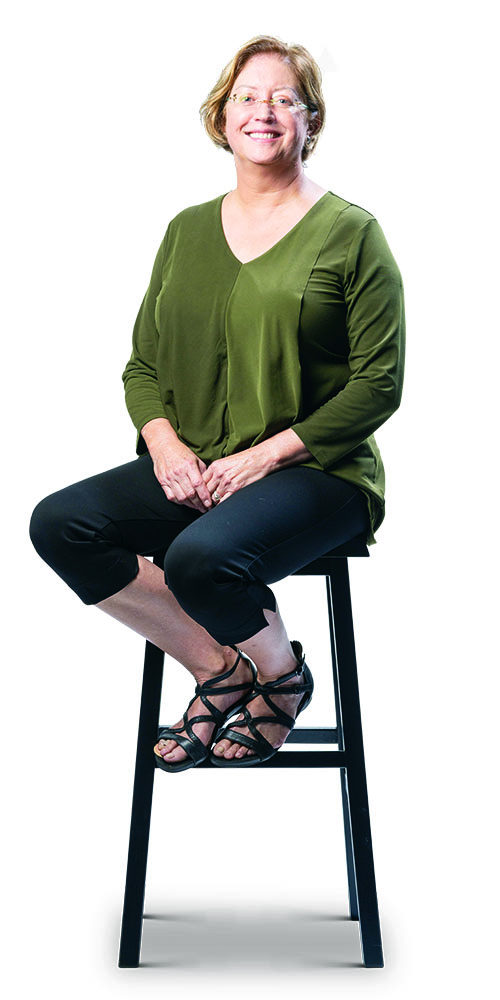
Shelagh Mulvaney. Photo by John Russell.
Managing Type 1 diabetes is hard at any age, but for the adolescent and teen population, it’s especially challenging. It requires a juggling act, even for the most motivated patient. Insulin dosing, diet and exercises must be balanced with frequent blood glucose monitoring. Moreover, Type 1 diabetes is the second most common chronic illness in teenagers, behind asthma.
When self-care such as insulin administration suffers, teens’ overall glycemic control (A1c) deteriorates. There are many factors contributing to inadequate self-care, including issues of stigma, trying to fit in with peer groups, and the need to shift responsibility appropriately from the parent to the teen.
Shelagh Mulvaney, PhD, associate professor of Nursing, and a team including Cindy Lybarger, MSN’90, FNP, work on research funded by grants from the National Institute of Diabetes Digestive and Kidney Disease (NIDDK) at the National Institutes of Health. The longtime collaborators are creating a program for adolescent patients that will integrate a digital patient self-management report with nurse practitioner and teen collaborative problem-solving. It will be based on patient-generated data and use tailored mobile text messages and digital stories to connect with patients between visits.
The technology makes use of the ever-present cellphone to model self-care problem-solving behaviors, support self-efficacy, and provide guided mastery to improve behavior in small steps.
“Diabetes outcomes for adolescents and young adults are the worst of any age group with Type 1 diabetes. There is a great need for additional individualized programming to improve and maintain self-care in order to prevent serious health consequences in the short- and long-term,” Mulvaney said. “These types of systems are highly relevant for teens because teens have few resources outside of clinic for guided problem-solving and support.”
The patient self-management report includes:
- identification of barriers to self-management that are common for teens, such as ‘time pressures and planning’ and ‘social support;’
- summaries on how the patient has adhered to goals based on data from their diabetes devices such as blood glucose meters and insulin pumps; and
- an individual problem-solving and goal-setting summary
During clinic visits, the NPs and teens will review the data on the report and use it to focus their goal setting and possible solutions. Between visits, teens will receive mobile communications – texts and digital stories — applicable to each individual teen’s situation.
Diabetes affects about 9% of the U.S. population and accounts for $174 billion in costs annually, according to the Centers for Disease Control and Prevention. About 193,000 Americans under age 20 are estimated to have diagnosed diabetes. In 2011-2012, the most recent information available from the American Diabetes Association, the annual incidence of diagnosed diabetes in youth was estimated at 17,900 with Type 1 diabetes and 5,300 with Type 2 diabetes.
Mulvaney and colleagues began working with this population of patients in 2009 using a website that improved adherence and glycemic control through modeling problem-solving skills.
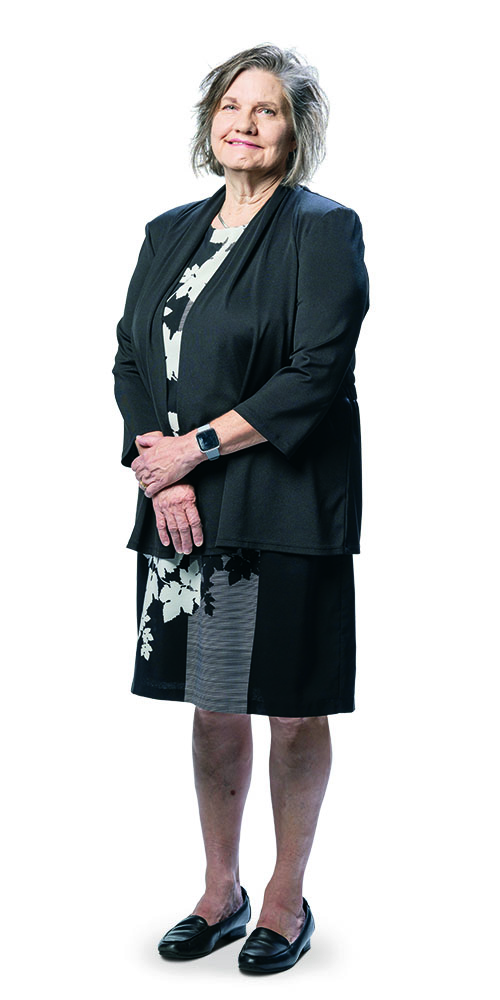
Cindy Lybarger. Photo by John Russell.
Lybarger said participating in the research has reinforced the need to be tuned in to barriers for individual patients, to talk about scenarios they are experiencing and help them apply principles of problem-solving. “We brainstorm a solution, try it and evaluate effectiveness.”
Mulvaney said she hopes the technology can soon be utilized widely so a clinician can determine what issues the teen patient is facing and prescribe a specific set of experiences or stories regarding a teen who is struggling with a similar issue.
“We hope the system will make support of self-management more efficient and efficacious. The cost effectiveness of the system will eventually be evaluated once we have estimates of efficacy. We’ve designed it for broad dissemination using readily accessible off-the-shelf technologies.”
Mulvaney and Lybarger said their collaborative relationship is beneficial to both.
“We complement each other in terms of perspectives, skills and strengths,” Mulvaney said. “Cindy, and nurse practitioners in general, are wonderful collaborators for behavioral science implementation. All of the NPs in the Eskind Clinic have been interested and willing to contribute to this clinical research. It would not take place without their continued efforts.”
Lybarger said she has worked with children, teens and young adults with diabetes, and their families, for 25 years.
“They are willing to participate in the research because they have a desire to help others with diabetes and because they trust their clinicians and believe we are working to improve their care,” she said.
“It’s clear to me there’s still much work to be done to improve diabetes self-care adherence and quality of life. Being involved as a collaborator with Shelagh has given me a broader perspective of the work I do as a clinician, which I’m able to share with my colleagues.”
Enhancing life in pediatric palliative care
by Nancy Humphrey

Terrah Akard. Photo by John Russell.
When Terrah Foster Akard came to Vanderbilt University School of Nursing in 2004 to get her PhD, she spent some time narrowing down her research focus. Then she heard a story from her adviser, Mary Jo Gilmer.
Gilmer, PhD, MBA, FAAN, told Akard about a dying child who would ask nurses and clinicians for Leggs brand pantyhose containers. After the child died, her family found the plastic egg-shaped containers around the house with notes and messages inside. The child wanted to be remembered.
“I had a passion for kids with life-threatening conditions who seemed to do and say things really special and dynamic and I wanted to learn more about that,” Akard said. After hearing the story from Gilmer, she said, “‘That’s it! That’s what I want to study.” And she has.
Akard, associate professor of Nursing, and a team that includes study coordinator and former Vanderbilt Pediatric Oncology Nurse Practitioner Sarah Wray, and co-investigators Gilmer, professor of Nursing and Pediatrics; Debra Friedman, MD, the E. Bronson Ingram Chair in Pediatric Oncology and director of the Division of Pediatric Hematology-Oncology; and Mary Dietrich, PhD’96, professor of Statistics and Measurement, recently completed a digital storytelling research project. They studied a web-based legacy-making intervention in 150 children ages 7-17 with advanced cancer and their parents. “Research I’ve been doing since my PhD program led to that study,” Akard said.
“Kids naturally create legacies. They don’t need our help making their mark on this world. They do that on their own just by being who they are,” she said. “What they sometimes need help with is documenting their legacies, to help confirm to them they will be remembered in the case of death, and to document what they went through for those who will be cured and go on to live long healthy lives.”
The basis of the research is that with 15,000 children ages 5-19 years dying each year in the U.S., the children and their family members are at high risk for suffering and long-term morbidity, Akard said. Legacy activities show promise in improving psychosocial outcomes among children with life-threatening conditions and their parents.
After a series of preliminary studies, the investigators developed a web program to create digital stories. “They were intended to be for the families to keep. They could keep them private or share them with the world. It was up to them,” Akard said.
The digital program consisted of questions that the children were instructed to answer about themselves, a way to upload photographs and video, and music.
“The questions weren’t about cancer or the hospital. They were about who they were as kids – what they like to do, their favorite things and hobbies, who was important to them,” Akard said.
“They could insert whatever information they wanted; the questions were a guide.”
The web program put together all the information and the children were sent an electronic link with their final story played in a movie-type format.
“Legacy making opened meaningful doors of communication between parents and their child,” said Wray, who was key to enrolling the patients and families. “It rendered valuable insight into the child’s feelings, emotions and thoughts without unnecessary probing or over discussions.”
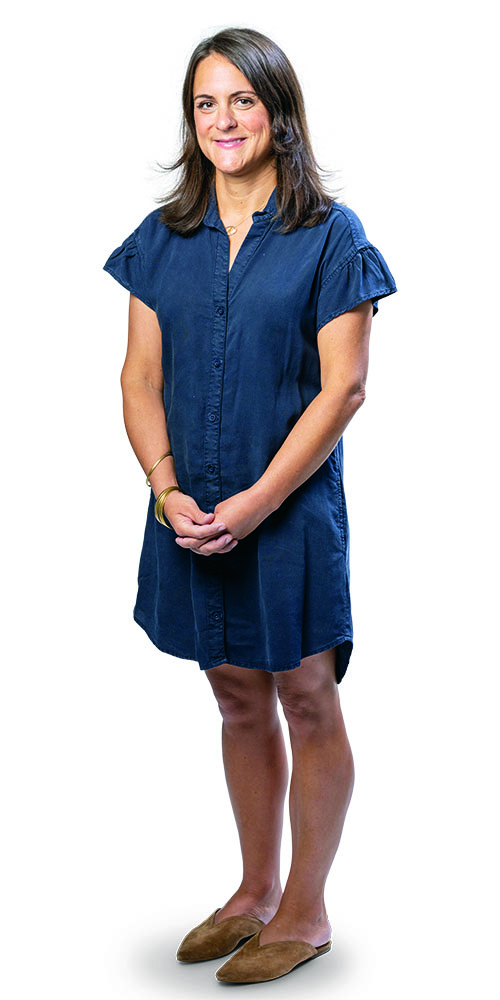
Sarah Wray. Photo by John Russell.
It also provided a fun and meaningful distraction from diagnosis and treatment, and spurred greater communication with family members, strengthening the parent/child bond, Wray said.
Akard said some of the responses to questions were very deep and beyond the developmental level they should be, based on children’s ages. Some were very simple – ‘my favorite color is blue’ and ‘I like baseball.’ Some were funny.
Akard hopes to expand the research to children with non-cancer diagnoses and those with cognitive delays. She is also considering studying bereavement in parents, particularly in the NICU.
“The original focus of this study was on helping the ill children, but we learned that legacy interventions can also bring benefit to their parents and families. Children with serious health conditions are often concerned about their family members, and legacy interventions may help them express and communicate their emotions.”
She also hopes, based on feedback from participants, that future studies can examine effects of increasing the intervention dose.
“These stories were snapshots of a short period in time (two weeks – two months). This was a pretty short period of time when you think about cancer. In the future we’d like the intervention to cover a longer part of their journey. Sometimes these children have years of treatment.”
Akard and Wray said that collaborations between the School of Nursing and the Vanderbilt clinical enterprise are invaluable because they benefit both the academic and clinical worlds.
“They increase the depth and breadth of research while allowing a larger number of children and families to be involved in, and benefit from, important research projects such as this,” Wray said.
Akard said her study wouldn’t have existed without the collaboration with Vanderbilt medical and nursing clinicians, specifically Wray.
“I’m a researcher. I’m not the one at the bedside,” Akard said. “I don’t have that bedside mindset. That’s not one of my hats right now. Clinicians are key to research projects like mine. The clinicians help ensure we’re creating something that will not only matter but will also work in the practice setting – that it’s feasible and doable.”


